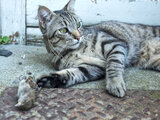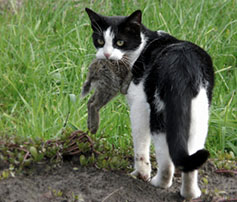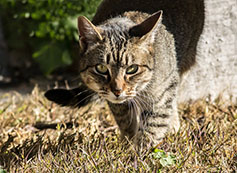The Threat of Cats to Wildlife
Cats present a serious threat to wildlife and local ecosystems, regardless of the fact we adore them as pets. Many of Australia's native species are unable to tolerate the high levels of predation from cats and are highly likely to become susceptible to extinction unless the cat problem is addressed. Controlling feral cat numbers and committing to keeping cats as indoor pets are the first steps in reducing wildlife harm.
 | Outdoor cats contribute to
33 extinctions globally |  | Australia’s cats
kill more than 1.5 billion
native animals every year. |
 | Stray and feral cats
kill three times as much
as pet cats |  | The average outdoor house cat
kills 2 native animals
every week. |
1.
Cats kill more than 1.5 billion native animals every year. Domestic and feral cat predation is the most serious human-caused hazard to wildlife. Outdoor cats kill more than 1.5 billion native species in Australia each year. Cats are natural predators that do not distinguish between nuisance animals and our native species.
2.
Domestic cats are one of the worst invasive species. Domestic cats contribute to the extinction of various species, making them one of the top 10 non-native invasive animals on the planet. Even if they're well-fed, outdoor cats prey on birds and other creatures. The average house cat with access to outside kills two native animals every week. It is a fact that local wildlife species are most protected when cats are kept inside or safely contained to the home.
3.
Outdoor cats contribute to 33 extinctions globally. Cats are non-native to many regions and cause environmental disruption. They are thought to be responsible for 33 extinctions throughout the world. Feral cats are the most serious hazard to endemic species, accounting for at least 14% of worldwide extinctions. In Australia, feral cats prey on numerous highly vulnerable and endangered species, including the bilby, numbat, and western ground parrot.
4.
Stray and feral cats kill three times as many animals as indoor pet. Feral cats help themselves to a phenomenal number of species in Australia – 400 different vertebrates. This includes 123 bird species, 157 reptiles, 58 marsupials, 27 rodents, 21 frogs and 9 exotic mammals. This is more than double the 179 species of animals that cats have been recorded eating on other islands worldwide. However, this list only includes those species that have been recorded in diet studies, so it’s likely that there are many other species of native animals that cats kill and eat, that we just don’t know about yet.
The Solution
Reducing feral cat influence on native wildlife is a difficult task, but it is critical in the struggle to preserve our distinctive fauna.
For Owners
Restriction of cats to their owners' land is the best option. This is also beneficial to cats' wellbeing since it reduces fighting and traffic accidents. For as little as $200, cat owners can build barriers along their fences to prevent their pets from escaping. While in your yard, a collar-worn predation deterrent may be considered to keep wildlife even safer.
When outdoors, even well-fed pet cats kill wildlife and cat bells do little to prevent this. Keeping cats indoors at night is only a partial response to the problem as they will continue their predatory behaviour in the daytime. The best solution for the welfare of cats and the protection of native wildlife is to always keep cats indoors or in a contained area whilst outside. If your cat is well stimulated contained cats are healthier, safer, less stressed, live longer and are less likely to need vet care due to injury or disease. Additionally, desexing cats prevents pregnancies reducing the number of unwanted cats that contribute to the feral cat problem and greatly lessens behavioural problems such as aggression and roaming once again resulting in a safer, happier, and healthier cat.
Cats are not the enemy and rather than demonising pet cats, responsible ownership should include compassionate and ethical containment for the protection of the cat and native wildlife.
Feral Cat Control
While the Australian Government has various bodies charged with feral cat management, on a large scale it is challenging without the commitment of the public. Responsible cat ownership is a factor in the overall reduction of opportunities for predation on wildlife. The Government through various inquiries has recognised the need to improve public awareness of Australia's feral and domestic cat problem. Contributors to these inquires have recommended public awareness campaigns providing information and reasons behind cat control programs such as desexing and containment based on strong evidence about cats’ impact on wildlife while emphasizing animal welfare.



